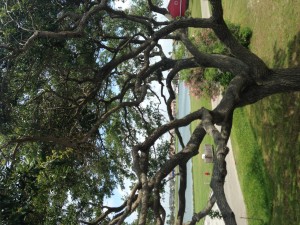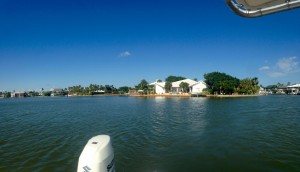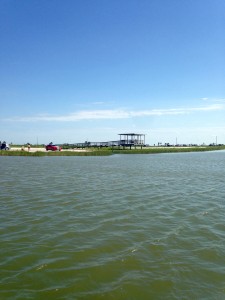For my last blog post, I took advantage of a weekend trip to Rockport, Texas. I have never been to the coast of Texas in my entire life, but I did grow up on the coast of Louisiana (New Orleans), so much of what I noticed was very similar to my hometown. Well if there is one distinction between New Orleans and Rockport its the wind. The first thing I noticed when I got to Rockport was how all of these oak trees limbs were bent and some were growing at a forty five degree angle. The day I got there, the weather was near perfect, seventy five degrees with a slight breeze. My friend who lives there, however, explained to me that this was not “normal” Rockport weather and the reason was the lack of wind.
Here, you can see the distorted look of a young Live Oak tree. I was thankful to have been there on a weekend where it was so pleasant. It made going out on the boat much nicer and manageable.
I really liked visiting the southern coast though. I did find a lot of similarities just in the appearance. For instance, the mixture of southern trees like Live Oaks with Palm Trees really reminded me of home. I grew up right on Lake Pontchatrain or the edge of the bowl of New Orleans and it is packed full of Live Oaks and sprinkled with Palm Trees. Interestingly, the area I grew up in was purely man made, in the sixties they built land on Lake Pontchatrain in order to manage the growing population. Similarly, the area of Rockport I stayed in was also man made. The water was extremely shallow and there were designated areas deep enough to permit boating traffic. I was curious weather the mixture of Palm Trees and Live Oaks was also evidence of this manmade area. I mean when I think Texas or Louisiana for that matter the image of Palm Trees doesn’t necessarily jump to mind… Nevertheless, there was still distinct evidence of this being a southern coast as there were little marsh like areas gathered around the beaches (so no perfect pensacola beaches), but they still had their own charm.
By discovering the manmade connections between the small town of Rockport and the area of New Orleans I grew up in, it reminded me of Aldo Leopold’s explanation of a conservationist. He states, “A conservationist is one who is humbly aware that with each stroke of the axe, he is writing his signature on the face of the land.” That being said, I think these two towns managed their jobs quite well. They gave homes to people that needed them or simply pleasant sites to have memories in. I mean after all, human beings, as a species are constantly seeking things to make them happy. Well this particular part of Rockport is generally the vacation site, and my part of New Orleans is for lack of better word the suburbs. However, both places seemed to making the efforts they could to minimize human influenced problems. For instance, like mentioned before, distinguishing to shallow areas, and to my surprise planting low maintenance trees in young soil like Palm Trees! Furthermore, I find that the people in this area, despite it being a small town with small town mentality, the community is tied to the environment whether its through boating, fishing, or sitting on your porch enjoying the view. Overall, it was a pleasant experience in a different part of Texas and gave me a bit more optimism concerning conservation.
After writing these blogs for some time now, I find it interesting as to how often while I looked at Nature, I was thinking about humans. Now, I firmly believe this is personally related, as I am not a scientific person and am fascinated by human beings. I mean even a lot of the visits I made to these places were shared with friends or shown to me by friends. I think this is an essential part of attempting to guide human behavior towards conservation efforts. I mean growing up in the south, I understand that it is hard to move away from the money making power of oil. Yet, at the same time, what if the million dollar houses these oil families buy on the coast of Texas or any other coast for that matter get drowned by rising sea levels?
I think that knowledge and education with an emotional cannon could really influence how people think of and treat nature. I mean having the distinct knowledge and education of what is good and bad for earth is important, but changing the behavior of even one human being takes time and an immense amount of effort. I find that one’s behaviors really only change through ones own positive and negative experiences in life. I mean it took a real bad hurricane for New Orleans to take the time to implement a well managed recycling system. Its unfortunate that simple changes like these seem to only occur when evidence of environmental problems directly affect us.
However, after looking through the word cloud from the compilation of our blogs this semester, I think I already see how people’s behavior towards nature changes the more time we actually spend with it. I mean words like “time” “noticed” “new” “felt” “different” “preserve” accompanied with words like “nature” “beautiful” “trees” “water” “sun” “land” are words that to me mirror thoughts and behaviors that are progressive as well as optimistic. Therefore, part of my own takeaway from this project is to maybe even for just a minute get those I’m spending time with to take a moment to appreciate something around us. Whether its just a flower, tree, or the temperature, I’ll bring their attention to the beauty around us. The beauty that we must keep working to preserve. They may not realize it at the time, but I think just like these blog posts it might take us a while to realize how are behavior is changing.


